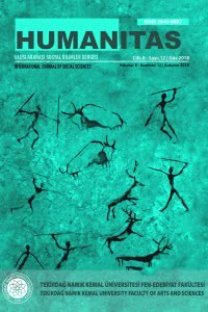Louis De Bernières’in Kanatsız Kuşlar Romanında Sosyal Kimlik Oluşumu
Bu çalışmanın amacı, Louis de Bernières’in Kanatsız Kuşlar romanındaki kimlik oluşumu kavramını tartışmaktır. Öncelikle, bu çalışma, kimliğin sosyal yapısını benlik, toplum ve sosyal yapılar üzerindeki etkisiyle araştıran kimlik teorilerinin gelişimini sunmaktadır. Postmodern bir roman olan Kanatsız Kuşlar, herhangi bir kimlik belirleyicinin kolayca çıkarıldığı, değiştirildiği ve dolayısıyla iktidarın bir sonucu olarak kararsızlaştırıldığı bir küresel kriz döneminde zorlu kimlik inşası meselesini tasvir eder. De Bernières’in romanının karakterleri, akıcı ve değişken kimlik belirleyicilerinin acı veren gerçeğiyle yüz yüze gelir; bu, “kesinliklerin”, istikrarlı bir özerklik duygusundan mahrum bırakan kimlik politikalarının bir sonucu olarak kolayca yeniden yapılandırılabilir ve yeniden inşa edilebilir olduğunu ortaya çıkarır.
Anahtar Kelimeler:
inşa edilen kimlik, sosyal kimlik, grup içi, grup dışı, akışkanlık
Social Construction of Identity in Louis De Bernıères’ Novel Birds Without Wings
The aim of the present study is to discuss the concept of identity formation in relation to Louis de Bernières’ novel Birds Without Wings. Primarily, this study presents the development of identity theories which investigate the social construction of identity with its impact on self, society and social structures. The postmodern novel Birds Without Wings depicts the stringent issue of identity construction in a period of global crises, when any identity markers are easily removed, changed and, therefore, destabilized as a result of the play of power. The characters of de Bernières’ novel confront the agonizing truth of the fluid and changeable markers of identity revealing that any “certitudes” are easily deconstructed and re-constructed anew as a result of identity politics which deprives one of a stable sense of selfhood.
Keywords:
constructed identity, social identity, ingroup, outgroup, fluidity,
___
- Beck, U.(1992). Risk Society: Towards a New Modernity, London: Sage
- Benwell, B. & Stokoe, E. (2011).Discourse and Identity.Edinburgh, GRB: Edinburgh University Press.
- Burke, P., & Stets, J. E. (2000). Identity Theory and Social Identity Theory. Social Psychology Quarterly 63(3): 224-237.
- Day, D. (2010). Membership categorization analysis. University of Southern Denmark. https://pdfs.semanticscholar.org/13fb/a5401c5b2b7c4d2f54e31cafd82c0e7143b4.pdf
- De Bernières, L. (2004). Birds Without Wings. Secker&Warburg, London.
- Hall, S. (2000). Who needs identity. Identity: A Reader, Londres, Sage. 15-30.
- Hegel, G. W. F., Miller, A. V., Findlay, J. N., & Hoffmeister,(1979). Phenomenologyof spirit. Oxford [England]: Clarendon Press.
- Kroskrity, P. (1999). Identify. Journal of Linguistic Anthropology, 9(1-2), pp.111-114.
- Sacks, H. (1972). Social science and conversation analysis. New York: Oxford University
- Schwartz, K. (2008). "It might be all one language": Narrative paradox in Birds without wings.Thesis.
- Taylor, C. (1989). Sources of the self: The making of the modern identity. Cambridge, Mass: Harvard University Press.
- Tajfel, H. and Turner, J.C. (1986). “The Social Identity Theory of Intergroup Behavior”. In: Worchel, S. and Austin, W.G., Eds., Psychology of Intergroup Relation, Hall Publishers, Chicago, 7-24.
- ISSN: 2147-088X
- Yayın Aralığı: Yılda 2 Sayı
- Başlangıç: 2013
- Yayıncı: Namık Kemal Üniversitesi
Sayıdaki Diğer Makaleler
“Susuz Yaz”da Mülkiyet, İktidar Mücadelesi ve Kadının Nesneleştirilmesi
Kuzey Amerikalı Şair Richard Fein’ın Yidiş Benliği
Iris Murdoch’ın Yapısalcılığı: Dile Olan Güvensizlik
Şiddet İçerikli Bilgisayar Oyunlarının Ergenlerin Saldırganlık Eğilimine Etkisi
Monomitik Kurmaca Söylem Olarak Oluşum Romanı: Büyük Umutlar'da Kimlik Oluşumu ve Öne Sürümü
Batılı Paradigmaların Dönüştürücülüğü Bağlamında Tanzimat Şiirinde Deist Etkiler
Kremlin Yanıyor: Alevlerin Dilinden 18. Yüzyıl Rusya’sı
